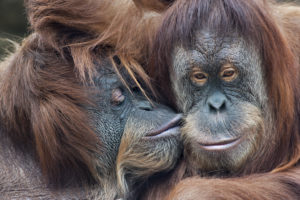Imagine you are at the seaside. Sunlight is hitting the surface of the ocean. Some wavelengths of light pass into the water, while others bounce off it, scattering in all directions. A tiny fraction of reflected light happens to reach receptors at the back of your eyeball, triggering electrical impulses that cause your brain to register the colour turquoise. Other rays from the sun fall directly on your skin, where receptors detect a sensation of warmth. A pulse of pressurised air from the lungs of a gull flying overhead sets up a wave of ripples in the air around it. As the wave travels outward, it bends sensitive hair cells in your inner ear, triggering an electrical signal creating the experience of sound.
We assume the information our senses feed us is objective — of course we do, because what else do we have to go on? There is something almost vertiginous, then, about Ed Yong’s new book, An Immense World: How Animal Senses Reveal the Hidden Realms Around Us, which confronts exactly how we perceive what we perceive. “Light is just electromagnetic radiation,” he says. “Sound is just waves of pressure. Smells are just small molecules. It’s not obvious that we should be able to detect any of these,” let alone that they should produce the particular subjective experiences that they do.
Your experience of a beach — the turquoise sea, the warmth of the sun, the screeching gull — isn’t what the beach is. The “real” beach is giving off all sorts of stimuli, only some of which a human brain uses to form a mental representation of its surroundings. There are many, many more stimuli that we cannot sense or even imagine sensing. But other species can.
Take the seabirds on the beach, for instance. Many seabird species are finely attuned to the scent of chemicals that give away the presence of the krill they eat, meaning that far from a flat, featureless expanse, the ocean’s surface has “a secret topography” of “odorous mountains and unscented valleys… invisible to the eye but evident to the nose”. Others are able to sense the Earth’s magnetic field, which guides them during migrations. And almost all birds can discriminate between “millions” of colours that humans are unable to imagine — to them, we are colourblind.
Some of the senses Yong details are delightfully surreal. A dolphin is effectively a “living medical scanner”: echolocation allows them to “perceive your lungs and skeleton… shrapnel in war veterans and foetuses in pregnant women”. Incredibly, beaked whales, which also echolocate, have “a strange assortment of crests, ridges, and bumps” on their skulls, which might be a form of “internal antlers” that could allow them to signal to others while retaining a sleek, hydrodynamic form.
What these alien senses might feel like, we can only guess. Philosophers have long grappled with this problem of subjectivity. Thomas Nagel, in his 1974 essay What Is It Like to Be A Bat?, argued that it is impossible to capture the experience of one sense by analogy to another: for example, “red is like the sound of a trumpet”. “That should be clear to anyone who has both heard a trumpet and seen red,” he wrote. It may be tempting to talk about dolphins “seeing” the inside of each others’ bodies, but in reality, it’s possible that what they experience via their sonar sense may be so different that trying to imagine it as a kind of “seeing” is as futile as describing the colour red in terms of its musical qualities.
Similarly, images meant to show us how ultraviolet looks to the many animals that can see it often render it as a kind of glowing purple. But to birds and bees, ultraviolet is an entirely different colour, one that no human eye has ever seen. These images are chasing the same impossible dream of children who try to invent a new colour by mixing their felt-tips. The only way for humans to see an entirely new colour, as different to our existing palette as red is from blue, would be to evolve a new colour receptor.
The biological term for these unique perceptual landscapes belonging to different species is Umwelten — German for “environments” — in this case meaning not just an animal’s physical environment but the environment as it appears to that animal. The Earth’s magnetic field is not part of our Umwelt as humans — it’s there, but we don’t sense it. A barnacle might exist on the same beach as us, but is oblivious to the peachy clouds in the sky as the sun sets: it lacks the capacity to perceive them. They are not part of its Umwelt.
The German zoologist Jakob von Uexküll, Yong tells us, coined this usage of Umwelt in 1909, comparing an animal’s body to a house “with a number of windows… a light window, a sound window, an olfactory window, a taste window, and a great number of tactile windows”. It is totally impossible for a mind inside the house to gain information about the outside world except via its windows; from vantage points in different houses, with windows made from different materials or placed at different angles, the same view would appear totally different.
Except, of course, we cannot switch vantage points. Every conscious being is permanently and inevitably stuck inside its own lonely house, through which all experience of the outside world is filtered; all communication with other minds must pass through the windows of their own houses before it can reach them. Our windows aren’t just limited by our bodies and physical senses, but also by our culture and past experiences. I can guess but I can never know what it would be like to have been born blind instead of sighted, or male instead of female, or in Tokyo instead of in London.
I am moderately high in neuroticism: one of the “big five” personality traits that describes a person’s tendency to worry and ruminate. Speaking to (mostly male) friends who are much lower in neuroticism (women are significantly more neurotic than men, on average), I am struck by how alien both ways of thinking are to each other: to have an inner monologue that points out hundreds of possible but unlikely hazards every day, or to be someone to whom these thoughts would never occur. How many more features of our temperaments and histories must there be that give each individual an inescapably different perspective on the same experience?
Nowhere is this more apparent than in today’s culture wars, when political opponents seem to inhabit entirely separate realities. Despite living through the same pandemic, those who think face masks in schools are a form of child abuse appear to be living on another planet from those who don’t allow their teenagers to leave the house for fear of long Covid. This is true, in a sense: we are all living in our own private Umwelten, with a slightly different view of the world filtering in through our unique windows. Perhaps the surprising thing, in a way, is that there’s so much agreement.
A century ago, we knew far less about the sensory capabilities of animals. Bat echolocation, dolphin sonar, and bird magnetoreception were all unknown — barely even guessed at — before the 20th century. These discoveries are testament to the awe-inspiring power of science, but they are also a much-needed dose of humility, reminding us of how much is out there beyond our perceptions. We hear a lot about the need to understand and defeat our “cognitive biases” — but in reality, our biases can never be escaped. They are our only window to the Immense World outside our own minds, whose full form remains permanently and tantalisingly out of our grasp.
Disclaimer
Some of the posts we share are controversial and we do not necessarily agree with them in the whole extend. Sometimes we agree with the content or part of it but we do not agree with the narration or language. Nevertheless we find them somehow interesting, valuable and/or informative or we share them, because we strongly believe in freedom of speech, free press and journalism. We strongly encourage you to have a critical approach to all the content, do your own research and analysis to build your own opinion.
We would be glad to have your feedback.
Source: UnHerd Read the original article here: https://unherd.com/




